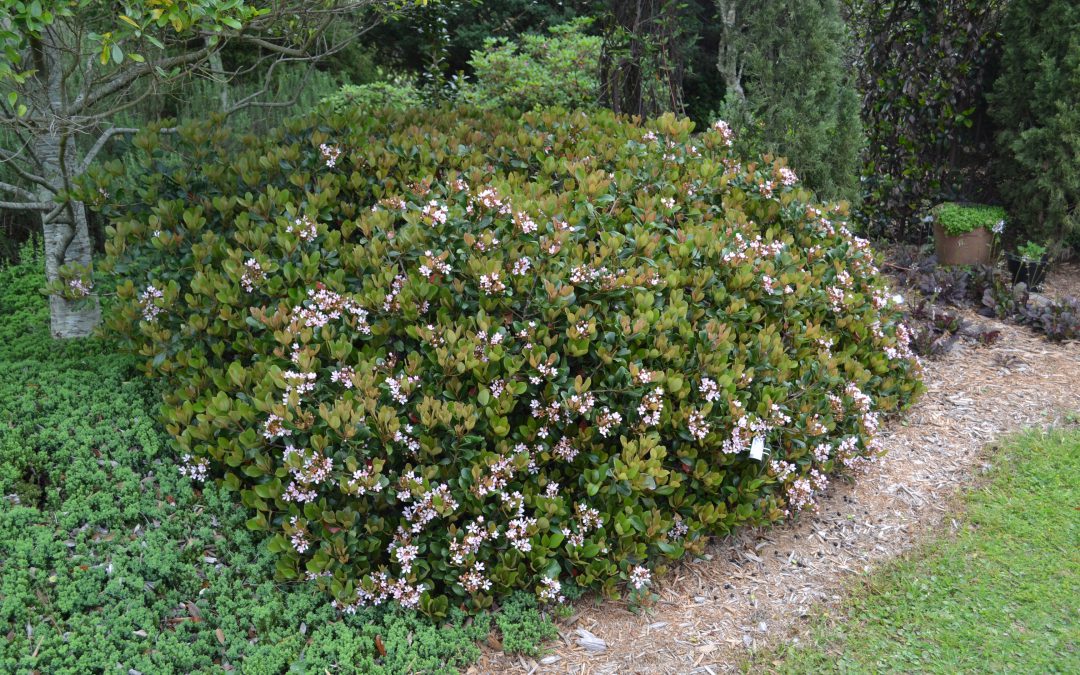
by Beth Bolles | Apr 7, 2015
One of the most commonly used shrubs in landscapes is the Indian hawthorn, Rhapheolepsis indica. Although not native to Florida, it can be a very attractive shrub when used properly in landscapes. Plants offer spring flowers in pinks and whites followed by berries that are a food source for birds.
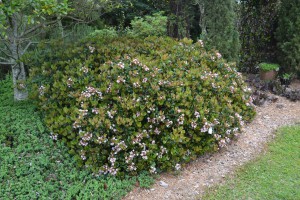
Indian hawthorn as a single planting can be attractive.
Indian hawthorn plants in landscapes are susceptible to a couple of pests that create unattractive and unhealthy plants. A leaf spot fungus called Entomosporium leaf spot easily spreads from infected plants through irrigation and rainfall leading to leaf discoloration, leaf drop, and dieback of limbs. Scale insects can also be common on leaves causing yellowing and dieback. The fungal problem is difficult to manage on heavily infected plants but the scale can be managed with a low toxicity pesticide choice such as a horticulture oil.
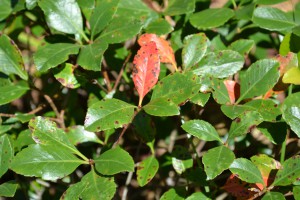
A heavy infection of leaf spot fungi is often too difficult to manage when plants are routinely irrigated.
Most often the problems on Indian hawthorn, especially fungal, are the result of poor management. This shrub likes sun, well-drained soil, and no overhead irrigation. Once established, plants should need little supplemental irrigation and water should only be applied to the base of plants. Since plants normally form a rounded mound, there is also little need for pruning if planted in a correct spot and spaced appropriately when planting. Most landscape installations of Indian hawthorn space plants based on the gallon pot size and not the mature size of the plant which is about 3-5 feet in height and spread.
Indian hawthorn can still be a good selection for homeowners. Buy healthy plants without any signs of spots on leaves and don’t plant a monoculture of these plants in the landscape. If one plant does have serious pest issue it is easier to either treat or remove one plant versus a mass planting.
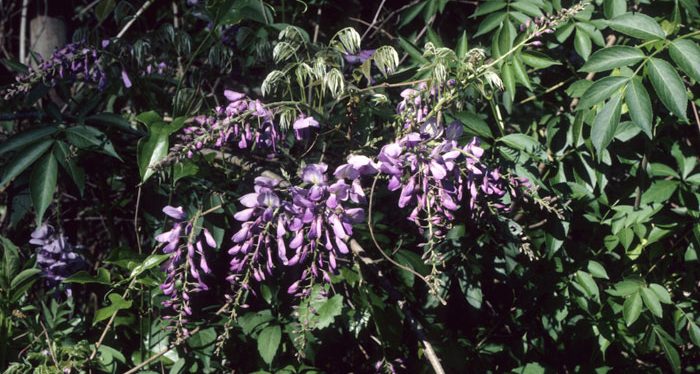
by Mary Salinas | Apr 6, 2015
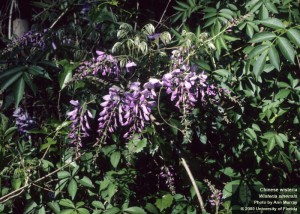 Maybe you have been seeing the Chinese wisteria, Wisteria chinensis, sporting its lavender blooms along the roadways this time of year. This vine may add a pleasant splash of color to the green leafy backdrop, but this is an invasive vine that has escaped our yards and gardens and is spreading on its own in natural communities.
Maybe you have been seeing the Chinese wisteria, Wisteria chinensis, sporting its lavender blooms along the roadways this time of year. This vine may add a pleasant splash of color to the green leafy backdrop, but this is an invasive vine that has escaped our yards and gardens and is spreading on its own in natural communities.
The University of Florida Assessment of Invasive Plants determined that this vine has caused long-term alterations in ecosystem processes and displaces native vegetation. According to the non-profit Florida Exotic Pest Plant Council (FLEPPC), Chinese wisteria is a category II invasive which means that the species has escaped cultivation and is spreading on its own into other unintended areas.
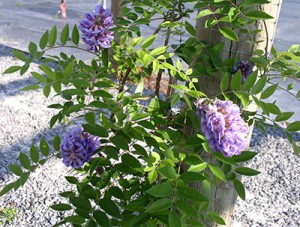
American Wisteria ‘Amethyst Falls’ at GCREC Teaching Gardens. Photo credit: UF/IFAS Extension.
Fortunately, there are several great alternatives to Chinese wisteria. A native vine, American wisteria, Wisteria frutescens, is a great alternative. The native cultivar ‘Amethyst Falls’ displays lovely fragrant lavender blooms in the spring and summer.
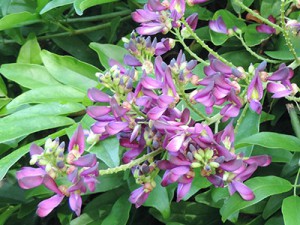
Evergreen Wisteria at the GCREC Teaching Garden. Photo credit: UF/IFAS Extension.
Another alternative is evergreen wisteria, Millettia reticulata, a twining vine (the stems twist around upright supports) that is semi-evergreen in the Florida panhandle. The deep mauve blooms appear throughout the summer months and persist often into the autumn.
So how do you get rid of the invasive Chinese wisteria? The vine can be severed at ground level and the stump immediately treated with a 25% solution of triclopyr or glysophate. There may be some resprouting of the vine from unaffected roots that would require retreating. Please click here for more details. The best time to control this vine is in the spring or summer when it is actively growing so that it will transport the herbicide to the roots and kill the plant.
For further information:
UF/IFAS Center for Aquatic and Invasive Plants: Chinese Wisteria
UF/IFAS Assessment of Invasive Plants: Chinese Wisteria
FLEPPC: 2013 List of Invasive Plants
UF/IFAS Gardening Solutions: American Wisteria ‘Amethyst Falls’
UF/IFAS Gardening Solutions: Evergreen Wisteria
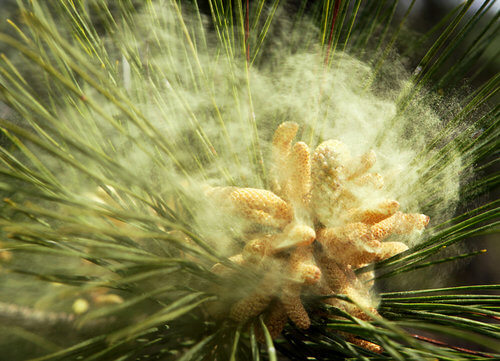
by Taylor Vandiver | Mar 24, 2015
It’s that time of year again, that time when your car changes color like a chameleon in order to mimic the surrounding landscape. Anything that stands still long enough will become coated with a light green to yellow dust. What is this dust you might ask? What you are seeing is pollen, a sure sign that spring has arrived and allergy season is here! The pollen that can be seen is from pine trees and is not a major contributor to allergies, but the invisible pollen from oak trees and other plants can wreak havoc on sinuses. And while you may be cursing the trees for causing your eyes to water and coating your car, it’s important to remember that plants need pollen in order to reproduce.

Pollen disseminating from a pine tree anther. Picture courtesy of http://supermanherbs.com/megadose-pine-pollen/
Pollen is disseminated from blooming trees and plants. The process of pollination develops new plant seeds. Pollen is dry and light, enabling it to float through the wind and travel several miles. Plants that depend on wind for dispersal have to produce massive amounts of pollen since only a small amount will actually result in seed production. Plants pollinated by insects don’t have to produce as much pollen because of the efficiency of the insects in distributing the pollen. Changes in the weather directly influence the amount of pollen and how it will affect allergy sufferers. Rain dampens pollen and reduces its ability to flow through the air. A freeze can also slow down a tree’s rate of producing pollen. Windy and warm weather can increase pollen amounts.
A Leon County allergy and asthma specialist stated that roughly 40 percent of the population suffers from pollen allergies. The best thing you can do if you are part of this 40 percent is to reduce your exposure to pollen. Here are a few ways you can keep your allergies at bay:
- Dry clothes in an automatic dryer rather than hanging them outside to avoid pollen collecting on clothing and being carried indoors.
- Consider limiting outdoor activities during the pollen season (Florida trees often release pollen from January to June).
- Stay inside during peak pollen times (from 10 a.m. to 4 p.m.).
- Restrict outdoor activities during days with high winds and low humidity.
- Shower after spending time outdoors to remove pollen from hair and skin.
- Use air filters and clean regularly, or run an air conditioner and change the air filter frequently.
- Wear a dust mask when mowing the lawn, gardening, or raking leaves.
If you would like to know what trees are producing pollen in your area at certain times of the year you can visit this website http://www.pollenlibrary.com/State/Florida/. As always, feel free to contact your local Extension Office for more information.
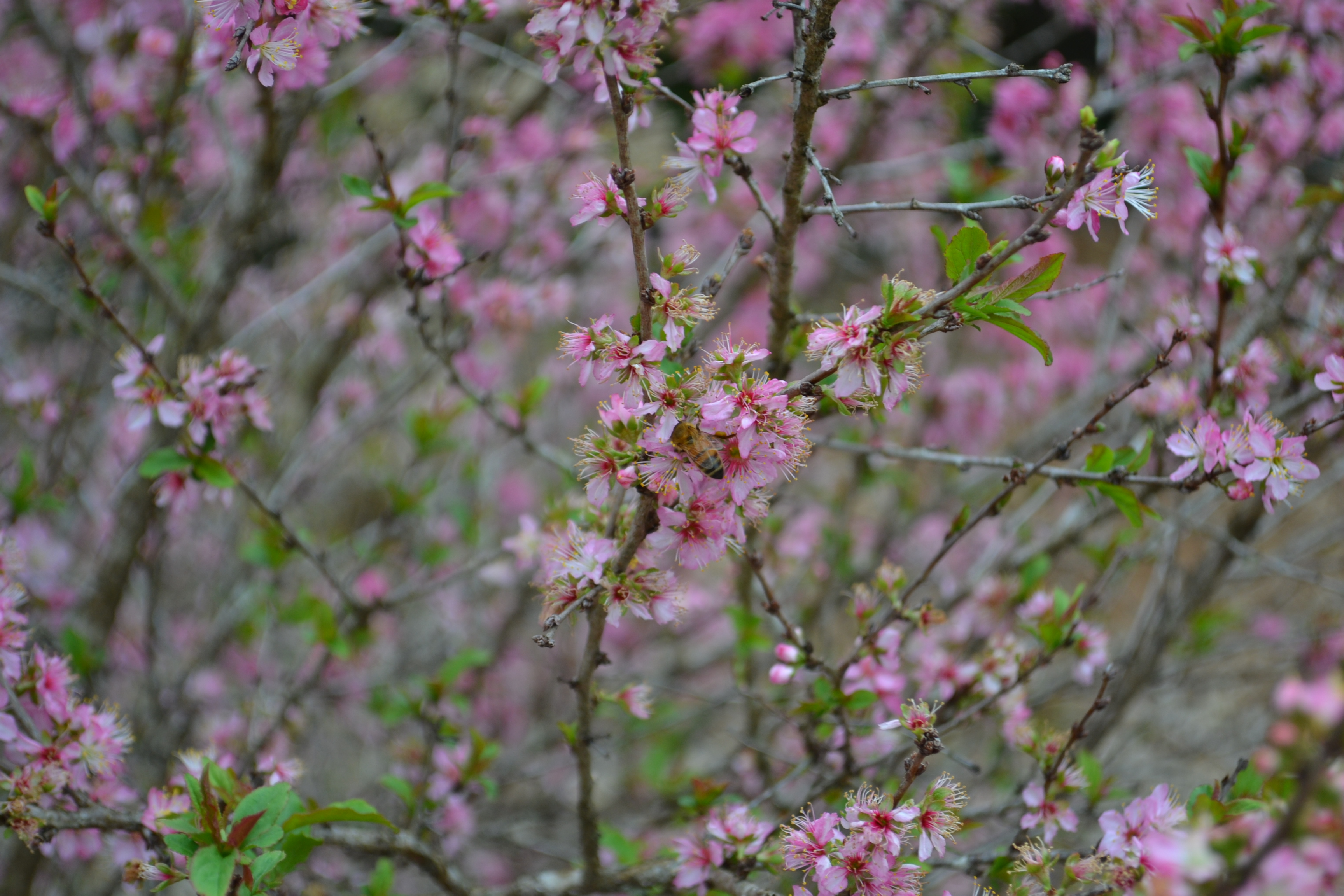
by Beth Bolles | Mar 10, 2015
Although we are not able to grow edible cherry trees in more southern climates, there are a few ornamental relatives of the cherry that are worth adding to the landscape. The Bush cherry, Prunus jacquemontii, is an attractive deciduous shrub that is a highlight with pink blooms in late winter. Flowers provide an early nectar source to bees.
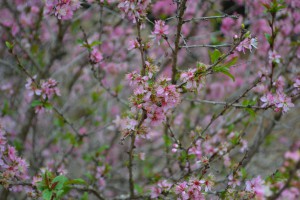
Bees are actively visiting flowers.
Plant the bush cherry is an area that receives sunlight and allows for the rounded shrub to grow about 5 feet by 5 feet. Plants like well-drained soil but benefit from some moisture during the growing season. Small berries serve as a food source for wildlife and can be used in jellies and jams. Leaves turn yellow in the fall before dropping. Plants are generally low maintenance and certainly brighten winter days. 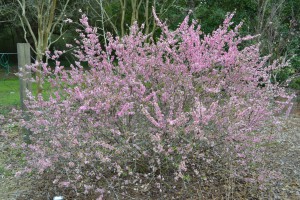
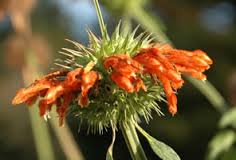
by Sheila Dunning | Mar 2, 2015
“If March comes in like a lion, it will go out like a lamb?”
Weather sayings can be quite colorful. Some of them may be connected to scientific observations, while others are more superstitious in nature. What the weather will do this month can change on a moment’s notice. March is definitely one of the more unpredictable months. One week the temperatures are warm and spring-like. A few days later the weather turns stormy and cold. Depending on the groundhog you follow, spring will be here, or not, in the next few weeks.
But, any long time Northwest Florida residents knows, summer will be here eventually and it is going to get hot and dry. So, while trying to figure out whether to wear your T-shirt or arctic parka today, take a moment to locate “that patch” of the landscape and consider adding a “lion” or “lamb.”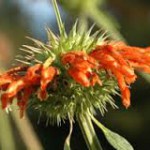
Lion’s ear and Lamb’s ear are two plants that survive under hot, dry conditions. Lion’s ear, Leonotis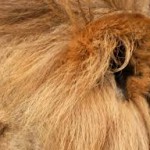 nepetifolia, is a tall-growing (8 feet) annual with orange tubular flowers that peek out of the spiny bloom head, giving the appearance of a lion’s ear. Hummingbirds reportedly hover next to a flower or even perch on a cluster, drinking for 10 seconds or longer. That’s an eternity in hummer world and about as long as any lion would tolerate someone messing with his ears.
nepetifolia, is a tall-growing (8 feet) annual with orange tubular flowers that peek out of the spiny bloom head, giving the appearance of a lion’s ear. Hummingbirds reportedly hover next to a flower or even perch on a cluster, drinking for 10 seconds or longer. That’s an eternity in hummer world and about as long as any lion would tolerate someone messing with his ears.
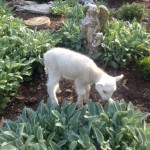 Lamb’s ear, Stachys byzantina, is an easy care perennial with wooly gray-green leaves and lavender colored flower spikes. It makes an attractive accent in a container or excellent groundcover that invites you to experience its soft “wool”, like those cute little ears of a baby sheep.
Lamb’s ear, Stachys byzantina, is an easy care perennial with wooly gray-green leaves and lavender colored flower spikes. It makes an attractive accent in a container or excellent groundcover that invites you to experience its soft “wool”, like those cute little ears of a baby sheep.
Both of these plants are self-sustaining species that establish well in open dry areas. The lion’s ear must self sow seed to return each year. Whereas, the lamb’s ear will return from the roots and can be divided if relocation is desired.
Lion or lamb, March is a good time to plan for easy care, summer, blooming flowers. While it may be “freezing” now, you know once it gets hot, the last place you will want to be is outside in the blazing sun. Maybe the thoughts will warm you.
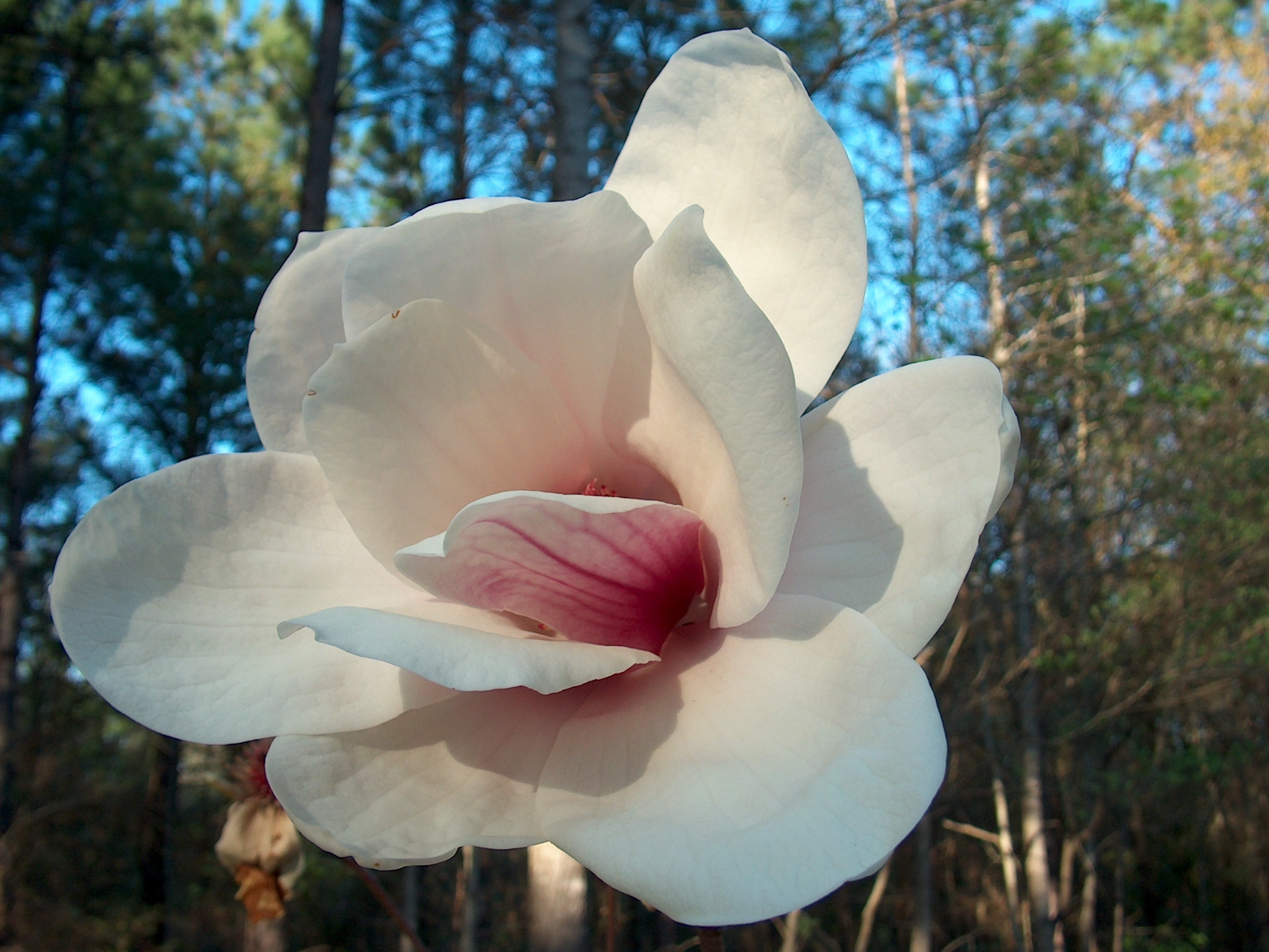
by Gary Knox | Feb 24, 2015
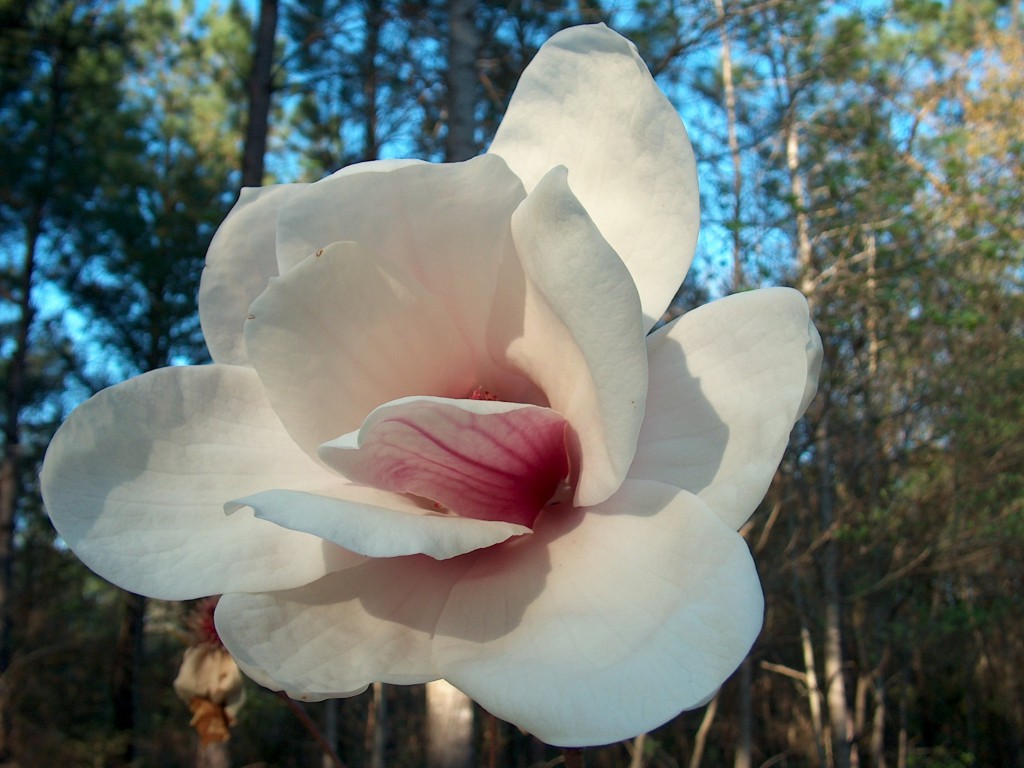
‘Jon Jon’ magnolia
This winter’s recurring freezes and frosts have played havoc with early flowering plants like magnolia. While buds are freeze-resistant, open magnolia flowers can quickly turn brown after exposure to temperatures about 30°F or lower. One way to avoid freeze-damaged flowers is to choose later blooming cultivars. These selections have flowers that open in north Florida during late February or later.
The Magnolia Garden at the University of Florida/IFAS North Florida Research and Education Center (NFREC) in Quincy has more than 150 types of magnolias planted. Based on over 10 years of data, five of the latest blooming magnolias are Daybreak, Jane, Betty, Jon Jon and Ann. These cultivars have peak bloom dates ranging from late February (Ann) to mid-March (Daybreak). Thus, they bloom after most flower-damaging freezes.
Daybreak has beautiful, large shell-pink flowers on a small tree. Jon Jon has huge white flowers with a streak of red-purple at the base. These fragrant flowers open goblet-shaped the first day, and then open wider to a cup-and-saucer shape on subsequent days. At NFREC, Daybreak and Jon Jon have about 6 weeks of flowers and grow as single-stem or multi-stem trees up to about 30 feet tall.
Jane, Betty and Ann are sister cultivars developed at the National Arboretum. As you would expect with sisters, they look-alike, and have a shrubby or multi-stemmed tree habit, generally growing about 15 feet tall and wide (much shorter and wider than Daybreak and Jon Jon). All three have upright, cup-shaped flowers in various shades of pink and red-purple. Betty has medium red-purple flowers that are the largest of the three, over 4 inches. Jane has 3- to 4-inch flowers that are medium pink outside and white or pale pink inside. Ann has the smallest flowers (3 inches) but they are also the darkest red-purple. As an added bonus, Ann boasts the ability to produce sporadic flowers all summer long! This results in Ann having an average of 13 weeks of flowers, as compared to Jane’s 10 weeks and Betty’s 8 weeks.
These five cultivars are generally available at garden centers during spring. Ann and Jane can be found at many “Big Box” stores. All five can be purchased at “good” independent garden centers and, as a last resort, from mail-order/Internet nurseries.
For more information about these and other magnolias, see Florida Extension publication, ‘Jon Jon’ Magnolia: A Late-Flowering Deciduous Magnolia for Northern Florida, and other magnolia publications here. Also, Magnolia Society International is a great resource with a very informative website. (Note the slide show below of Jon Jon, Ann, Betty, Daybreak and Jane.)
[portfolio_slideshow id=4059]















 Lamb’s ear, Stachys byzantina, is an easy care perennial with wooly gray-green leaves and lavender colored flower spikes. It makes an attractive accent in a container or excellent groundcover that invites you to experience its soft “wool”, like those cute little ears of a baby sheep.
Lamb’s ear, Stachys byzantina, is an easy care perennial with wooly gray-green leaves and lavender colored flower spikes. It makes an attractive accent in a container or excellent groundcover that invites you to experience its soft “wool”, like those cute little ears of a baby sheep.
